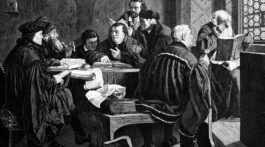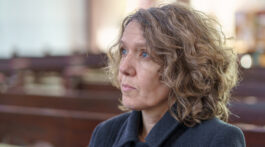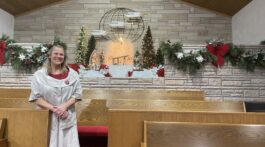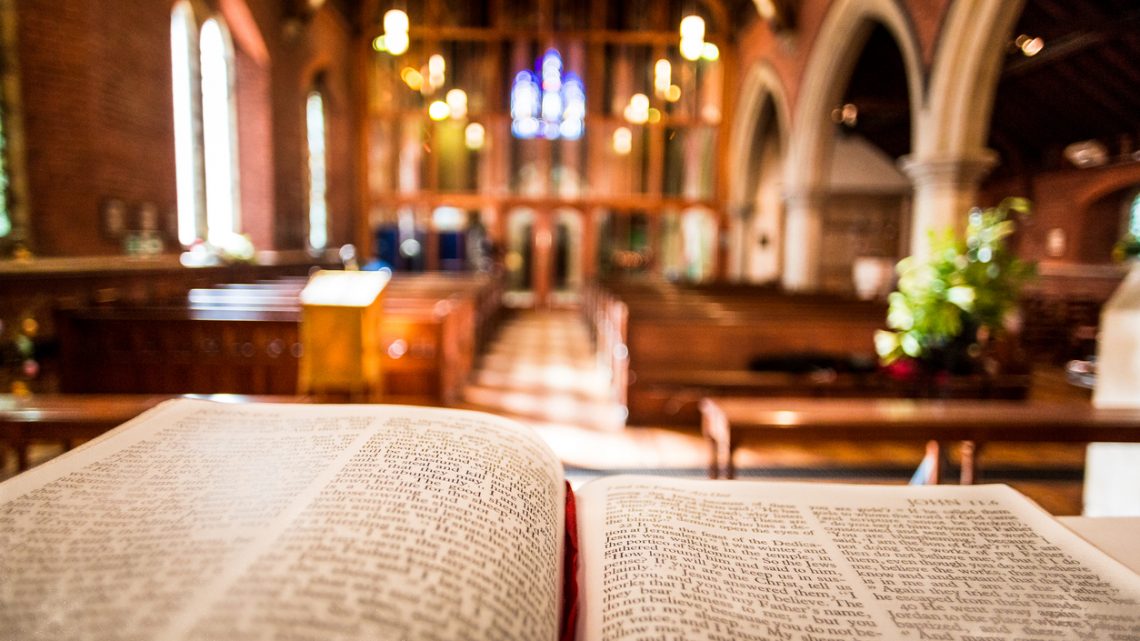Sabbath School Lesson for January 12-18, 2019
Overview
Following the message to Ephesus, John was given six other messages for churches in Asia. These seven churches also represent seven periods of church history, seen in even more detail in subsequent chapters. [dates are approximate estimates of the times involved]
- Ephesus (the loveless, apostolic church–33-100 A.D.)–last week’s lesson
- Smyrna (the persecuted, post-apostolic church–100-313 A.D.)–Sunday
- Pergamum (the church of compromise–313-538 A.D.)–Sunday
- Thyatira (the corrupt, medieval church–538-1565 A.D.)–Monday
- Sardis (the dead church of the Reformation–1565-1740 A.D.)–Tuesday
- Philadelphia (the faithful church of the Great Awakening–1740-1844 A.D.)–Wednesday
- Laodicea (the lukewarm church in the last days–1844-present)–Thursday
Introduction
The prophetic dream given to King Nebuchadnezzar and interpreted by Daniel was perhaps the most convincing evidence in the Old Testament of God’s ability to tell the future. The various materials that comprised the image in the king’s dream stood for subsequent empires that would dominate the world after Daniel’s time, the Babylonian period. We have seen these secular kingdoms fulfilled in amazing detail, with the rise of the Medo-Persians, the Greeks, the Romans, and now our present, post-European, modern world.
We find in Revelation another amazing prophecy that sums up, not worldly kingdoms, but the history of God’s church. The church, too, has seen many transformations throughout the centuries, and we can’t help but be convinced of God’s prophetic powers. The fulfillment of His predictions indicate that He indeed is in charge of world events, and will see that the final salvation of this world is finally realized.
Once more we are humbled to find ourselves living in the last days of earth’s history. How important for us to know and understand this God, who has provided for His people all along, and will continue to give us strength to survive whatever trials Satan brings us.
Memory Text: ” ‘ “To him who overcomes I will grant to sit with Me on My throne, as I also overcame and sat down with My Father on His throne.” ‘ “ Revelation 3:21 NKJV
Notice that each of the seven churches we study this week are told to overcome. We must be overcomers of Satan’s attacks, in order to enjoy the rewards that Jesus provides, when our struggles on this earth are finally over.
Sunday: Christ’s Messages to Smyrna and Pergamum
The second church mentioned in John’s vision was to the church in Smyrna. This was a wealthy city, but was also steeped in emperor worship. Failure to comply with their laws concerning this worship resulted in increased persecution of God’s church in Smyrna.
The post-apostolic church (considered to be around 100-313 A.D.) fits this description of being a persecuted church, as the Roman Empire stepped up its actions against Christians. Revelation 2:10 even mentions tribulation for ten days, which could refer to the ten years of intense persecution under Emperor Diocletian from 303-313 A.D. It was in 313 that Constantine the Great issued the Edict of Milan, which finally granted Christians the freedom to worship.
The third church would then be the one in Pergamum, where many pagan cults thrived. The cult of emperor worship was also prominent there. It was here that many compromises were embraced and God’s church was beginning to see more rapid spiritual decline. This paralleled the time period (313-538 A.D.) when the Catholic church was being formed, and many, subtle compromises with paganism were adopted by its leaders.
Discussion Questions:
Read Revelation 2:8-11. What kind of challenges does this church in Smyrna have? How does Jesus’ words give them hope and encouragement, despite the threat of persecution that was growing even more after John’s time?
Read Revelation 2:12-17. Ephesus, the first church, was told to repent and go back to its first love. Why was Pergamum also told to repent? Why is compromise such a dangerous route for God’s people to take, and why is it commonly done in order to stop persecution?
Read Matthew 5:10-12. Why should persecution not disturb us? How can looking back at martyrs in the past give us courage to face our own trials today?
Monday: Christ’s Message to Thyatira
This message to Thyatira should hold our attention a little longer. Its prominent location in the center of these messages to the churches, in Hebrew thought and logic, alerts us that it is the climax of the passage. We even find its message to be twice the length of the other six churches.
This fourth church is seen to be more corrupt than any of the others. Jezebel, the wicked queen and wife of King Ahab, is even mentioned in its description (Revelation 2:20-22).
There are four “women” mentioned in Revelation, each of them representing God’s church. These two comprise the church, led astray by Satan…
- Jezebel, who figuratively led the church astray in the past, especially in the Middle Ages (the time of Thyatira)–Revelation 2:20-23
- the scarlet women of Revelation 17, called Babylon, and present in the last days
Then, these two represent God’s faithful church…
- the godly woman of Revelation 12, who figuratively survived especially during the Middle Ages, and had to flee into the “wilderness” in order to escape persecution
- the bride of the Lamb, God’s holy church, who is finally allowed to join Him at the Marriage Supper in heaven–Revelation 19:7, 8
Discussion Questions:
Read Revelation 2:18 and Daniel 10:6. Why was Jesus so dramatically revealed to the church in Thyatira, just as He was to Daniel?
Read Revelation 2:19. What did it mean that their last works are more than their first? What was happening at the end of this church period of papal supremacy in 1565?
Read Revelation 2:20-29, 12:6, 13, 14, and Matthew 24:20-22. How does God’s church escape persecution of this magnitude? How do we know it will be even more intense at the end of time?
Tuesday: Christ’s Message to Sardis
Like Pergamum, the third church, we also see compromise at Sardis during the Reformation period (1565-1740 A.D.). Sardis, however, is described as a spiritually dead church. Even though no open sins are mentioned, as was the case for Pergamum and Thyatira, we see Sardis in a lethargic state, in need of true spiritual revival and repentance.
It’s easy to see a bit of Sardis mentality in God’s people even today. We may have led a life of devout faithfulness in our past, but we have become content to call ourselves Christians, maybe even attend church services, and yet lack any genuine commitment to spread the gospel to others in any tangible way.
Those in Sardis are found not watching for Christ to come. But many promises are given for those who truly repent of past mistakes and find a place for God in their hearts.
Discussion Questions:
Read Revelation 3:1-8. Why is the church at Sardis called a dead church? In what ways and for what reasons do they fit this description?
Read Revelation 3:3 and Matthew 24:42-44. Why is it important for us to watch and be ready at all times?
Read 1 Thessalonians 5:4-8. How does sobriety fit into this picture of a lethargic church? How does drinking affect our sleep? In what ways must we be watching AND sober as we wait for the Day of Christ’s Advent or Coming?
Wednesday: Christ’s Message to Philadelphia
From 1740-1844 A.D. there was seen a worldwide, missionary spirit engulfing Protestant churches, called the Great Awakening. There was even a movement within Christianity proclaiming the Second Coming of Christ, known as the Great Advent Movement, prior to 1844 and led by William Miller.
The sixth church mentioned in Revelation, Philadelphia, seems to fit this description. The name Philadelphia means “brotherly love”. It is seen as a faithful church, and parallels in some ways, the second persecuted church in Smyrna. These churches appear to be close to being on the right track spiritually, and are encouraged to persevere despite trials and hardship.
Verse 8 curiously mentions an “open door”. This is thought to be the door to the sanctuary or throne room of God in heaven. Notice in Revelation 4:1, 2 a door is standing open in heaven, and John is told to enter it. He finds himself in the throne room, which would correspond to the Most Holy Place in the earthly temple.
Some Adventists, in studying further the prophecies proclaimed by William Miller, were led to study the symbolism and instruction found in the sanctuary, and were able to unlock many salvation truths found there.
A new interest developed in keeping all ten of the Ten Commandments, which were found in the Ark of the Covenant of the Most Holy Place, ultimately leading to a new denomination in the 1800s, which called themselves Seventh-day Adventists.
Discussion Questions:
Read Revelation 3:7-9 and 4:1, 2. What “door” might these verses be talking about?
Read Revelation 3:10, 11, 2:9, 10, and 14:12. Why must the Philadelphia church be patient, and how does this match the words given to the church in Smyrna?
Read Revelation 3:12, 13, 7:4, 22:4, and Psalm 23:6. How are we sealed, and why is it important for God’s people to be sealed?
Thursday: Christians in Laodicea
The seventh and final church, which received a message from Christ, was Laodicea. There were noticeably, as with the other churches, identifying marks with the actual churches in Asia they addressed. For instance, in Laodicea, we find…
- it was a wealthy city on a major trade route (gold was found there)
- it had a medical school (which produced eye salve)
- they refused help from Rome, when the city was destroyed by an earthquake around 60 A.D.
- an aqueduct came from a hot springs quite a distance away, causing the water to be lukewarm by the time it reached the city
This church in Laodicea also fits perfectly into the scope of church history in these final days before the Lord comes. Although it had much going for it, it was accused of being lukewarm. Its spiritual fervor gone from its previous experience, sounding much like the Ephesus church at the beginning, which had lost its first love.
We, in the end times, would do well to heed the counsel of Christ to this church. Rather than depending on our own good works, abundant spiritual gifts and wisdom, we must look to Christ, the supplier of all we need or want.
We, like Ephesus, must repent and become zealous once again for the Lord.
Discussion Questions:
Read Revelation 3:14-16. Why is a “lukewarm” state not acceptable in this final church of Laodicea?
Read Revelation 3:17-19 and Matthew 7:4, 5. What kind of eye salve is needed by a hypocrite and why? How are God’s people today like those Jesus identified as hypocrites during His earthly ministry?
Read Revelation 3:20-21 and Luke 12:36, 37. Why does God not force us to serve Him? Why is His Kingdom one of invitation only?
And, Finally…
Be sure to notice the prescription Jesus gave for the Laodiceans (Revelation 4:18). They needed…
- gold, representing faith (“that the genuineness of your faith, being much more precious than gold that perishes, though it is bested by fire, may be found to praise, honor, and glory at the revelation of Jesus Christ.” 1 Peter 1:7 NKJV)
- white garments, representing our salvation (“I will greatly rejoice in the Lord, my soul shall be joyful in my God, for He has clothed me with the garments of salvation, He has covered me with the robe of righteousness,…” Isaiah 61:10 NKJV
- eye salve, representing wisdom (“that the God of our Lord Jesus Christ, the Father of glory, may give you the spirit of wisdom and revelation in the knowledge of Him, the eyes of your understanding being enlightened; that you may know what is the hope of His calling, what are the riches of the glory of His inheritance in the saints,” Ephesians 1:17, 18 NKJV
Continuing to memorize Psalm 91 this quarter, let’s add the third verse, which speaks of our being delivered from the snare of the fowler, obviously Satan. That certainly is a welcome promise to add to God’s church in these final, Laodicean days.
“He who dwells in the secret place of the Most High, shall abide under the shadow of the Almighty. I will say of the Lord, ‘He is my refuge and my fortress; my God, in Him will I trust.’ Surely He shall deliver you from the snare of the fowler and from the noisome pestilence.” Psalm 91:1-3 NKJV
Next Week’s Lesson: Worthy Is the Lamb
To read the Sabbath School Lesson Quarterly or see more resources for its study, go to https://www.absg.adventist.org/
Other Outlook blogposts by Teresa Thompson, are at http://outlookmag.org/author/teresathompson/










